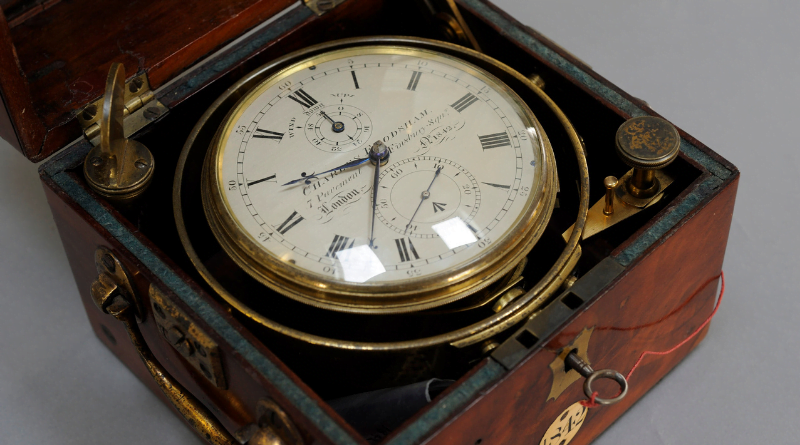
The marine chronometer, a highly precise timekeeping device, serves as an indispensable tool for ascertaining longitude during maritime expeditions. It proves instrumental in accurately charting a ship’s location on the vast canvas of the Earth. The legacy of marine chronometers stretches across centuries, bearing witness to their pivotal role in the annals of maritime exploration.
Historical Evolution of the Marine Chronometer
Determining longitude at sea posed an enduring challenge to mariners over the ages. Before the advent of marine chronometers, celestial bodies such as the sun and stars were the sole reference points for establishing longitude. This method’s accuracy, however, waned during protracted voyages and adverse weather conditions.
In the 18th century, the British government initiated an enticing reward of £20,000 for the innovation of a dependable sea-bound longitude calculation method. This incentive ushered in a period of inventive fervor, leading to the birth of the first practical marine chronometer in 1761, engineered by the English clockmaker, John Harrison.
Harrison’s chronometer was an engineering marvel. Crafted from brass and steel, it found refuge in a wooden encasement to shield it from the rigors of the ocean. The chronometer featured a balance wheel suspended by a spring, its precision governed by a temperature-compensated pendulum. This breakthrough ensured that the chronometer maintained impeccable accuracy, even amidst tempestuous seas and fluctuating temperatures.
Harrison’s creation heralded a navigation revolution. It empowered sailors to pinpoint their longitude with exceptional precision, opening up the possibilities of safe long-distance voyages and the exploration of uncharted territories. Notable explorers like Captain James Cook and Captain George Vancouver relied on marine chronometers to traverse the world’s oceans.
The Modern Role of Marine Chronometers
In contemporary times, marine chronometers have not been rendered obsolete, although electronic navigation systems, such as GPS, have assumed prominence. Nonetheless, marine chronometers still occupy a crucial niche as indispensable backup instruments, mandated aboard all commercial vessels.
Modern marine chronometers transcend the accuracy of Harrison’s era. Typically fashioned from quartz or atomic clock mechanisms, they exhibit precision to the tune of a few seconds per annum. Moreover, they offer enhanced durability, ensuring their resilience in the harsh marine environment for prolonged periods.
The Future Prospects of Marine Chronometers
Though no longer the primary navigational tools of the maritime domain, marine chronometers persist as valuable assets for sailors. Furthermore, their utility extends into other domains, including surveying, astronomy, and geodesy.
Future iterations of marine chronometers are poised to offer even greater sophistication and precision. Integration with other navigation systems is on the horizon, promising heightened reliability and precision in the realm of maritime navigation.
The Diverse Applications of Marine Chronometers
Marine chronometers serve a versatile array of applications, encompassing:
Navigation: Enabling the precise determination of longitude at sea, thereby facilitating accurate tracking of a vessel’s global coordinates.
Surveying: Providing the means to measure distances and angles with remarkable accuracy, a critical asset in the domains of land and sea surveying.
Astronomy: Offering a dependable timekeeping reference, crucial for conducting precise astronomical observations.
Geodesy: Serving as instruments of great import in the accurate measurement of the Earth’s dimensions and contours.
The Advantages of Employing a Marine Chronometer
Utilizing marine chronometers imparts several invaluable advantages, including:
Precision: These chronometers stand as epitomes of timekeeping accuracy, unfazed by turbulent seas and fluctuating temperatures, ensuring impeccable timekeeping.
Sturdiness: Constructed from robust materials like brass and steel, and sheltered within wooden casings, marine chronometers are engineered to withstand the formidable challenges of the maritime environment.
Dependability: Marine chronometers are steadfast and reliable companions, engineered to operate for extended periods without requiring maintenance.
Versatility: They find application across an array of domains, including navigation, surveying, astronomy, and geodesy, making them multifaceted timekeeping tools.
Selecting an Appropriate Marine Chronometer
When choosing a marine chronometer, it is imperative to take into consideration the following pivotal factors:
Accuracy: The chronometer’s accuracy is quantified in seconds per day. Opt for a chronometer with an accuracy rating of +/- 1 second per day or superior.
Durability: Look for chronometers crafted from robust materials such as brass and steel, encased in wood for durability and protection.
Reliability: A marine chronometer should be a paragon of reliability, capable of operating seamlessly for numerous years without the need for frequent maintenance.
Adaptability: For applications spanning diverse domains like navigation, surveying, astronomy, and geodesy, selecting a chronometer tailored to such multifaceted use is paramount.



